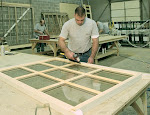Is it just me or do you think it is extremely difficult to get a straight answer these days? Life seemed to be so much simpler thirty years ago when business deals were done with a handshake and character was something one earned rather than purchased. Today I can reduce my age by ten years with a simple Botox treatment, and become a stallion with a little blue pill. I see the same smoke and mirror routine widely practiced in the replacement window industry. The enormous sum of money associated with replacement windows has created an industry that fuels deception and false truths. This is evidenced by the large number of FTC lawsuits against replacement window companies for false advertising last year.
There are two major advantages promulgated by the replacement window industry that fail to pass the reality test. The first is that energy efficiency garnered by replacement windows will have a positive payback over a short period of time. The other is that replacement windows are low maintenance and will have lower overall repair costs. Let us take a close look at both of these factors to see if they hold water.
The operational cost of a window is defined as the cost of energy to heat and cool the area around the window. A more energy efficient window will have lower operational costs and this reduction is the crux of most window decisions. Since the major window manufacturers test their windows, they have published statistics on key energy efficiency metrics such as air infiltration, U/R values, and solar heat gain. Existing historic windows do not have such published statistics so it can be difficult to make a direct comparison.
Bailey Edward Architecture conducted a detailed study comparing two versions of restored windows to a leading manufacturer of aluminum clad wood windows to evaluate the actual operational cost difference. In this study, a replacement window was installed next to a restored single-pane wood double hung with a storm window and a restored wood double hung that was converted with insulated glass. All three window openings were tested by an independent testing laboratory that specializes in fenestration testing. The following were the results of the study:
Window Type Air Infiltration U Value Solar Heat Gain
Existing with Storm 0.03 0.441 0.597
Restored with IG 0.12 0.362 0.320
ReplacementWindow 0.01 0.322 0.329
Now these statistics may not mean much to the lay person, but they certainly refute the claims you see on the websites of major window manufacturers who claim 83% better energy efficiency. Bailey Edward applied the tested performance data of the three different windows to the actual energy costs of the building in question using historic heating and cooling costs. The results of this extrapolation showed that the existing window with a storm would have a total annual energy cost of $173,541. The restored window with an insulated glass conversion had total annual energy consumption of $170,395 and the replacement window had a figure of $171,880. This study effectively cuts through the misinformation promoted by the replacement window industry. There is no significant operational cost difference between restoring existing windows with a storm window or insulated glass and replacing the windows.
Maintenance Costs
Bailey Edward did an excellent job of analyzing the maintenance costs of the three different window types. Maintenance items like repairing a spring or cord, exterior painting, interior painting, caulking, and cleaning were all incorporated in the cost evaluation. These costs were totaled for a 50 year expected lifespan and then annualized for direct comparison. When these costs were summarized for the building in question, the existing window with a storm had the highest annual maintenance cost of $66,763 because of the increased cost of having to clean four surfaces of glass. There was virtually no difference in the annual maintenance costs of the restored insulated glass window and the replacement version with those units recording $50,642 and $49,071 respectively.
Another critical factor that isn’t widely known is that most replacement windows are designed so that it’s not possible to replace the insulated glass when it fails. They are designed to be replaced not repaired. The life expectancy of insulated glass is difficult to predict because it depends upon the size of the glass, temperature and atmospheric pressure fluctuations, wind loads, working loads, sunlight, and exposure to water and water vapor. The replacement industry warrants the glass for 20 years. On average you can expect a double seal insulated glass with a good desiccant to last 30 years. An old-growth wood window will last ten times that since it can be maintained. So why would someone want to replace a window with a 300 year lifespan with one that has only 30?
When one evaluates the true operational and maintenance costs of replacement windows compared to window restoration it’s clear that the case for replacement is weak. Restoring historic windows still makes economic sense in the long run. Unfortunately, window restoration just doesn’t have the sex appeal, marketing budget, or LEED backing of the replacement window industry. Instead of automatically giving old windows a shot of Botox by replacing them, why not restore them to their original beauty? That way they can age gracefully for another 50 years and maintain the authenticity of the structure.






Hi, nice post. Well what can I say is that these is an interesting and very informative topic. Thanks for sharing your ideas, its not just entertaining but also gives your reader knowledge. Good blogs style too, Cheers!
ReplyDelete- The historic wood window ma